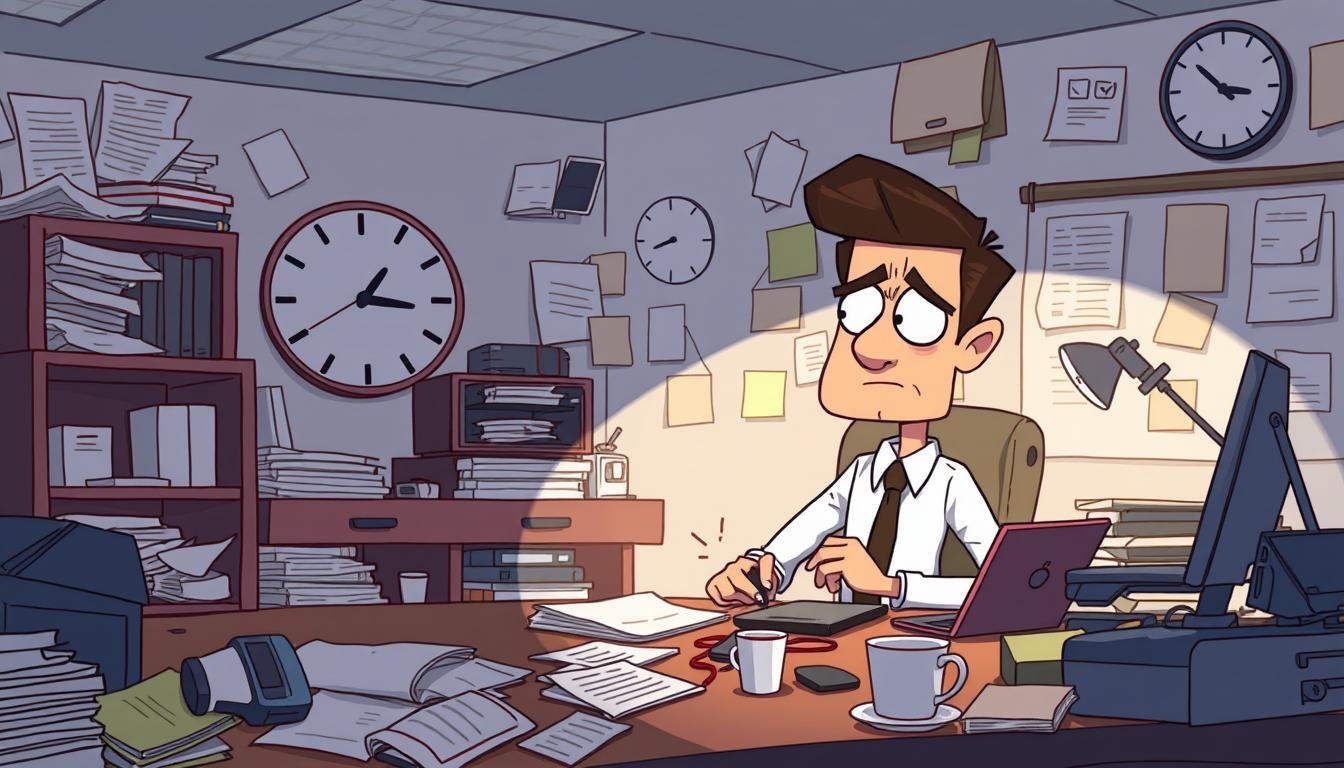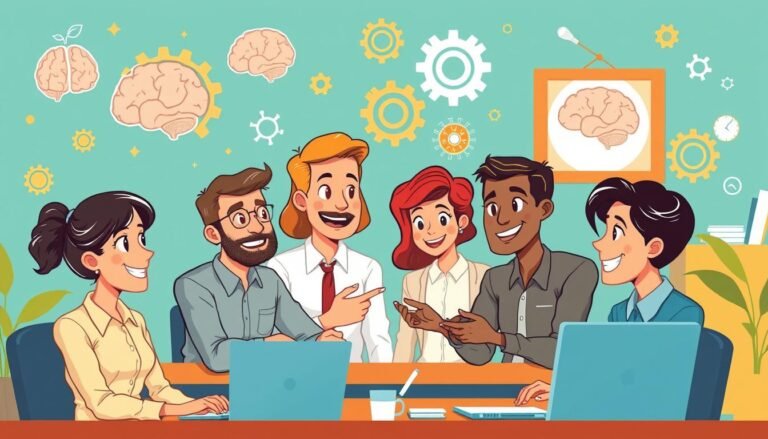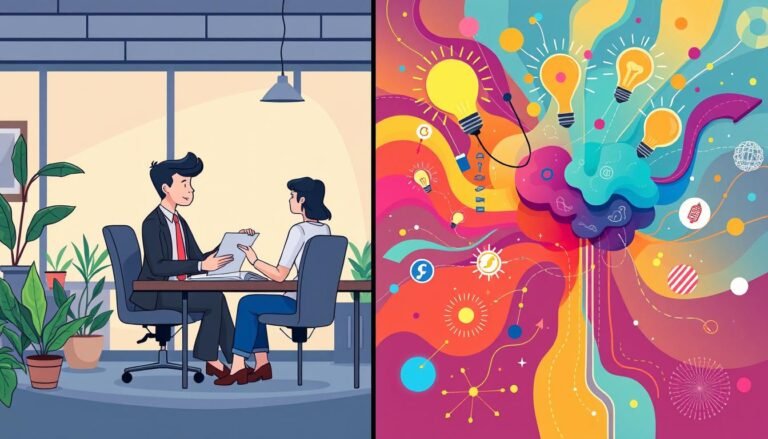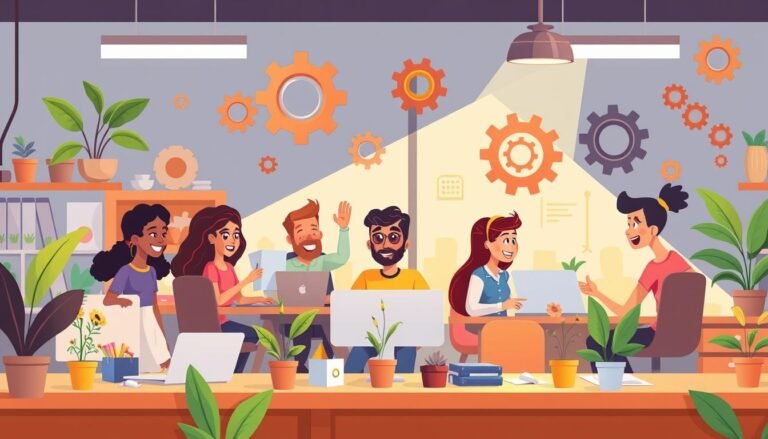Decision Fatigue in Organizations: Psychological Tips to Keep Employees Sharp
Ever wonder why your sharpest employees start making sloppy choices by day’s end? The culprit might be lurking in the shadows of your office: decision fatigue. This sneaky mental exhaustion creeps up on us, sapping our ability to make sound choices after a long day of decision-making.
In today’s fast-paced work environment, employees face a barrage of choices from the moment they clock in. As the day wears on, their mental reserves deplete, leading to a phenomenon known as choice overload. This can result in poor judgment, reduced productivity, and even burnout.
Understanding and addressing decision fatigue is crucial for maintaining a high-performing workforce. By recognizing the signs and implementing strategies to combat this mental drain, organizations can keep their teams sharp and engaged throughout the workday.
Key Takeaways
- Decision fatigue stems from prolonged periods of decision-making
- It affects employee performance and can lead to burnout
- High-stakes choices and stress contribute to mental exhaustion
- Symptoms include procrastination and difficulty concentrating
- Effective strategies can help combat decision fatigue in the workplace
Understanding Decision Fatigue in the Workplace
Decision fatigue is a big problem in workplaces. It makes people less productive and less creative. This happens when there are too many choices, draining our mental energy.
Definition and Causes of Decision Fatigue
Decision fatigue happens when we make too many choices. It uses up our mental energy. Even small choices add up. Forbes Coaches Council says it can make teams less happy and less creative.
Impact on Employee Performance
Decision fatigue has big effects:
- Reduced productivity
- Impaired self-control
- Increased susceptibility to biases
- Delayed decision-making
It affects many professionals:
- Parole judges grant fewer paroles later in the day
- Physicians make unwise decisions after long shifts
- Students’ exam scores decline in later test sessions
Signs and Symptoms to Watch For
It’s important to know when decision fatigue is happening. Look out for these signs:
- Procrastination
- Impulsive choices
- Difficulty concentrating
- Irritability
- Mental exhaustion
- Decision paralysis
- Setting up decision-making matrices
- Establishing clear systems and processes
- Delegating tasks effectively
- Using the 5-5-5 method for decision prioritization
By using these strategies, companies can fight cognitive depletion. This helps improve overall performance.
The Science Behind Decision Fatigue
Decision fatigue happens when we make choices all day long. Our brains get tired from over 35,000 decisions a day. This leads to trouble making good choices and is linked to ego depletion, where our willpower weakens.
Cognitive Depletion and Its Effects
Every decision we make uses up our mental energy. This makes it harder to make smart choices. For example, judges are more likely to grant parole in the morning than in the afternoon.
The Role of Glucose in Decision-Making
Glucose is key for making decisions. Our brains need it to work well. When glucose levels go down, so does our ability to make decisions. That’s why eating sugary snacks can help for a bit.
Neurological Processes Involved
Studies using fMRI scans show how decision fatigue works. They found that our brains get less motivated after making many decisions. People with Parkinson’s disease, who often have low dopamine, feel especially fatigued and unmotivated.
| Time of Day | Decision Quality | Glucose Level Impact |
|---|---|---|
| Morning | High | Optimal |
| Afternoon | Moderate | Declining |
| Evening | Low | Depleted |
Knowing about these scientific factors helps us fight decision fatigue. It keeps our minds sharp all day long.
How Decision Fatigue Affects Leadership
Leaders face a big challenge in making decisions. They deal with many choices every day, leading to decision fatigue. This makes it hard for them to make good decisions.
A study shows that almost 70% of executives feel burned out. This burnout comes from the old ways of working and the new business world. When they need to make quick decisions, it can be tough for them.
- Over-delegation: Pushing decisions down the chain of command excessively
- Micromanagement: Obsessing over minor details due to fear of making wrong choices
- Procrastination: Putting off important decisions
- Impulsive decision-making: Making hasty choices without proper consideration
To fight decision fatigue, leaders can use a few strategies. They can focus on the most important decisions, use clear frameworks, and delegate well. By managing their mental energy, leaders can stay sharp and lead their teams better.
| Impact of Decision Fatigue | Mitigation Strategy |
|---|---|
| Reduced willpower | Rationing decision-making |
| Cognitive biases | Using decision-making frameworks |
| Decision avoidance | Prioritizing high-impact decisions |
| Poor quality choices | Delegating based on team strengths |
The Unique Challenges Faced by Founder CEOs
Founder CEOs face special challenges that can cause mental exhaustion and choice overload. They handle many roles every day. They make countless decisions that shape their companies’ futures.
Multitasking and Role Juggling
Founder CEOs do many things, like sales, marketing, team management, and planning. Switching between these roles quickly drains their mental energy. This leads to decision fatigue.
Emotional Attachment to Decisions
Founder CEOs are deeply connected to their businesses. This connection makes decisions harder and emotionally draining.
High-Stakes Decision-Making
Every decision a founder CEO makes can have big consequences. The pressure of these decisions adds to their mental exhaustion.
| Decision Type | Impact | Stress Level |
|---|---|---|
| Strategic Planning | Long-term company direction | High |
| Financial Allocation | Resource management | High |
| Team Management | Employee morale and productivity | Medium |
| Product Development | Market competitiveness | High |
To fight choice overload, founder CEOs can focus on their company’s mission and values. This helps make decisions easier and reduces mental fatigue.
Decision Fatigue and Its Impact on Organizational Culture
Decision fatigue can harm an organization’s culture. Leaders, facing cognitive depletion, struggle to make good choices. This affects the whole company. Studies show that decision quality drops as the day goes on, especially for judges.
Willpower drain affects more than just leaders. Employees handle about 300 tasks daily, leading to less productivity and more mistakes. A University of California, Irvine study found that switching tasks can lower IQ by 13 points.
Organizations dealing with decision fatigue face several challenges:
- Reduced creativity
- Analysis paralysis
- Impulsive decision-making
- Poor resource allocation
- Declining employee morale
To fight these problems, companies need to reduce cognitive load. They should simplify communication, set specific times for decisions, and encourage breaks for mental rest.
| Time of Day | Decision Quality | Recommended Action |
|---|---|---|
| Morning | High | Make important decisions |
| Afternoon | Moderate | Handle routine tasks |
| Evening | Low | Avoid critical choices |
By understanding decision fatigue’s impact, leaders can create a better work environment. This not only enhances decision-making but also promotes a culture of well-being and efficiency.
Strategies to Combat Decision Fatigue
Decision fatigue can make it hard to make choices and lead to decision paralysis. With people making about 35,000 decisions a day, finding ways to fight this mental exhaustion is key.
Prioritizing and Streamlining Decisions
To fight decision fatigue, focus on the big choices. Cut down on small decisions by making routines. For example, plan your outfits for the week ahead. This saves mental energy for more important tasks.
Implementing Decision-Making Frameworks
Use structured methods to make complex choices easier. Tools like the SWOT analysis or cost-benefit matrix can help. They make it easier to organize your thoughts and avoid getting stuck.
Delegating Effectively
Don’t try to solve every problem yourself. Let your team handle decisions when you can. This cuts down on your mental work and helps your team grow.
- Use tools like Objective and Key Results (OKRs) to align teams with business strategy
- Focus on setting direction rather than giving detailed instructions
- Trust your team’s judgment on day-to-day operational decisions
By using these strategies, you can beat decision fatigue. This boosts your productivity and keeps your decision-making sharp all day long.
The Importance of Mental and Physical Well-being
Mental and physical health are key to fighting decision fatigue and ego depletion. Studies show that our ability to make decisions gets worse as the day goes on. This can lead to feeling overwhelmed by too many choices.
A study in Health Psychology found that nurses made poor decisions without breaks. This shows how important it is to take time off and do things that refresh our minds and bodies.
Here are some ways to keep your mind and body healthy:
- Exercise regularly to reduce stress and improve thinking
- Practice meditation or mindfulness to stay focused
- Get enough sleep to help your brain work better
- Eat a balanced diet to keep your body nourished
- Take short breaks between tasks to avoid getting too tired
Research in the Journal of Personality and Social Psychology found an interesting difference. Western people show signs of decision fatigue, but Indian people don’t. This shows that culture can affect how we handle making decisions.
By focusing on our mental and physical health, we can make better decisions. Small changes in our daily lives can make a big difference in how well we make choices.
Decision Fatigue
Many professionals struggle with decision fatigue, leading to mental exhaustion and lower productivity. With Americans making about 35,000 decisions each day, it’s important to know the signs and how to fight it.
Recognizing the Signs
Signs of decision fatigue include procrastination, making impulsive choices, and trouble focusing. You might put off decisions or rush into them. This can lead to analysis paralysis, where you can’t decide because you’re overthinking.
Immediate Coping Mechanisms
Here are quick ways to deal with decision fatigue:
- Take short breaks to recharge
- Practice mindfulness to clear your mind
- Use decision-making frameworks to simplify choices
Long-Term Prevention Strategies
To avoid decision fatigue long-term:
- Develop an agile leadership mindset
- Embrace a “test and learn” approach
- Balance alignment and autonomy in team decision-making
Using these strategies can help reduce mental exhaustion and enhance your decision-making skills over time.
| Time of Day | Decision Quality | Recommendation |
|---|---|---|
| Morning | High | Make important decisions |
| Afternoon | Moderate | Handle routine tasks |
| Evening | Low | Avoid critical choices |
Creating a Decision-Friendly Work Environment
A workplace that supports decision-making fights choice overload and willpower drain. It boosts productivity and improves employee well-being. This is crucial for any organization.
Clear communication and transparency are essential. Encourage a “fail fast, small and early” mindset. This empowers employees and lets them make decisions with confidence.
Leaders should lead by example, adopting a “test and learn” approach. Design work as a series of low-stakes experiments. This method lowers decision-making pressure and fosters innovation.
“Creating a supportive environment is crucial for combating decision fatigue. When employees feel empowered to make choices, they’re more likely to stay engaged and productive.”
To tackle choice overload, limit options when you can. For instance, instead of 20 shades of blue for office decor, choose 3-5. This makes decisions easier without losing quality.
| Strategy | Benefit |
|---|---|
| Clear communication | Reduces ambiguity in decision-making |
| Low-stakes experiments | Encourages innovation and risk-taking |
| Limiting options | Decreases choice overload |
| Flexible work hours | Allows for personal peak decision times |
Offer flexible work hours when you can. This lets employees make key decisions when they’re most sharp. It reduces willpower drain during the day.
Technology and Tools to Reduce Decision Fatigue
In today’s fast-paced work environment, technology offers valuable solutions to combat decision making impairment. By leveraging innovative tools, organizations can help employees maintain sharp cognitive functions throughout the day.
Automation and AI Assistance
Artificial Intelligence (AI) systems can handle routine decisions, freeing up mental energy for more complex tasks. These smart tools process large volumes of data quickly, supporting human decision-making processes. For instance, in finance, AI-powered platforms assist portfolio managers in making informed investment choices, reducing cognitive depletion.
Decision Support Systems
Advanced Decision Intelligence (DI) platforms combine AI and data analytics to streamline decision-making. These systems can decrease decision steps by up to 20% compared to standard recommenders. In healthcare, DI supports clinical decisions, while in supply chain management, it optimizes inventory decisions using real-time data.
Productivity Apps and Software
Specialized apps help prioritize tasks and manage workflows, cutting down on daily decisions. Some tools can reduce decision selection by 39% compared to heuristic strategies. By automating routine choices, these apps allow employees to focus their mental resources on high-impact decisions, promoting a more efficient work environment.
Source Links
- How to Deal with Decision Fatigue at Work: Tips & Examples
- Five ways to avoid decision fatigue | Ready Resilience
- Council Post: Feeling Drained? 14 Ways To Beat Decision Fatigue At Work
- An Effective Way to Avoid Decision Fatigue At Work
- polman_vohs_2016_spps_decision_fatigue_0
- What doctors wish patients knew about decision fatigue
- The Science of Decision Fatigue | Full Focus
- Understanding the Fluctuating Nature of Fatigue
- Decision Fatigue: Definition, Examples, and Tips – Work Life by Atlassian
- Decision Fatigue for Leaders – Moving People to Action
- 4 Ways CEOs Can Overcome Decision Fatigue | Vistage
- Decision Fatigue: Is it really a thing? – Your CEO Mentor
- Striking the Balance: How Decision Fatigue Impacts Your Team’s Efficiency
- The Rising Epidemic of Decision Fatigue
- Decision Fatigue: 6 Ways to Defog Your Brain
- Council Post: 6 Tactics To Reduce Decision Fatigue
- 8 Signs of Decision Fatigue and How To Cope
- Decision fatigue: Effects, causes, signs, and how to combat it
- How Stress Impacts Decision Making
- Decision Fatigue: A Conceptual Analysis
- Decision Fatigue: What It Is and How to Avoid It
- Decision Fatigue and Many Other Fatigues
- Having Trouble Making Decisions? — What to Do About Decision Fatigue
- Overcoming Decision Fatigue for Busy Executives
- 7 Ways to Avoid Decision Fatigue
- Decision Fatigue and DI: How Technology Can Improve Our Choices?
- Avoiding Decision Fatigue with AI-Assisted Decision-Making







